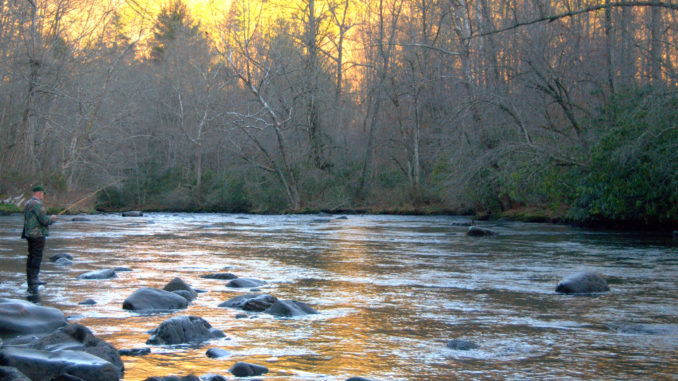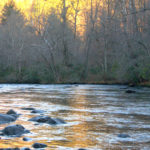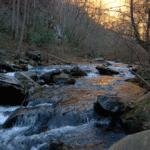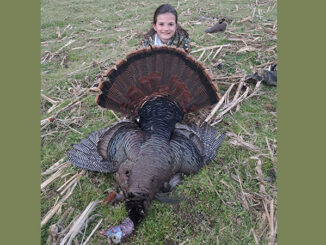
Prime paddling water is also great trout stream
The Nantahala River in Macon and Swain counties is primarily known for its challenging white-water rapids that attract paddlers — amateur as well as Olympic-class — by the thousands during the summer and fall, it is also widely recognized as one of the mountain area’s premier trout streams, so good that Trout Unlimited included it on its list of the top 100 trout streams in the United States — along with the Davidson River.
While fishing opportunities may be limited during the paddling season, especially in the lower section, trout fishers often have the stream to themselves beginning in early winter and continuing through early spring.
Originating in southwestern Macon County near Standing Indian, the Nantahala flows northwest to the Clay County line and continues along the boundary of the two counties to the Little Tennessee River and finally to Fontana Reservoir in Swain County. Miles before the river reaches Fontana, however, it is impounded to form Nantahala Lake in Macon County.
The lower Nantahala has three distinct fisheries; a 3-mile section from the dam on Nantahala Lake to White Oak Creek is hatchery-supported waters; a 4-mile section from White Oak Creek to the powerhouse is delayed-harvest waters, and the 8-mile section from the powerhouse to Wesser Falls is hatchery-supported waters.
The delayed-harvest section is stocked in March, April, May and July, and again in November and December with 18,500 brook, rainbow and brown trout. The hatchery-supported upper section is stocked with 2,000 trout in March, April, May and July. The lower hatchery-supported section is stocked with 5,000 trout during the same period.
Jim Borawa, a former fisheries biologist with the N.C. Wildlife Resources Commission, said the hatchery-supported section below the powerhouse has a much larger population of wild trout than the delayed-harvest section because of abundant nutrients. Also, he said, “water quality is good enough to support natural reproduction.”
Due to the abundant nutrients, it is not unusual to hook a 3- or 4-pound rainbow or brown trout in the lower section. Many of the fish in the lower section are carryovers from earlier stockings.
The Nantahala has excellent and plentiful hatches of Blue-Winged Olives. The most prolific hatches occur in early spring, but hatches occur even during the winter, especially on warm, sunny days. Recommended sizes are Nos. 24 to 18. Midge hatches also are common during the winter. When the Blue-Wings aren’t hatching, go with dark-colored nymphs such as a Hare’s Ear, rubber-legged Girdle Bug or Woolly Booger. Minnow-imitation streamers also are effective, especially in large pools.
Water levels above the powerhouse are fairly constant, but the flow below the dam can be erratic. When the turbines are on in the powerhouse, the stream is strictly whitewater country as it gushes through the gorge. Water levels can rise quickly, and fishers are advised to exit the stream if they notice the river starting to rise.
US 19 west of Bryson City parallels the lower section of the Nantahala from Nantahala Falls to just below the powerhouse. Access to the delayed-harvest section is off US 19 on Old River Rd. at the Nantahala River Launch Site Recreation Area. The road along the delayed-harvest section is paved, with numerous pull-offs.
The delayed-harvest section gets tremendous pressure because of its easy access and frequent publicity. On weekends in the early part of the delayed-harvest season, just about every pull-off is filled with vehicles, many from South Carolina, Georgia, and outlying areas of North Carolina, especially Charlotte.
On a trip to the river in late December, I saw one trout fisher in the lower section. I had the delayed-harvest section to myself.
An added bonus to fishing the Nantahala River is the scenery. The upper section has numerous waterfalls and cascades, some dropping several hundred feet down the steep sides of the gorge.
The Nantahala River produced the state-record brown trout in 1998; it weighed 24 pound, 10 ounces. Robert Dyer of Sylva caught the fish with a Rapala — but not in public fishing waters. It was in the powerhouse section, which is off-limits to public fishing. Dyer was able to fish that section because he was an employee of Nantahala Power and Light Co., which operated the power plant at that time. The big brown had been feeding on chum created by the powerhouse turbines.
Because of heavy whitewater activity during the day, the N.C. Wildlife Resources Commission allows night fishing on the Nantahala River downstream from the Swain County line. The Nantahala River and portions of Green River in Polk County are the only two trout streams in the state where night fishing is permitted.







Be the first to comment